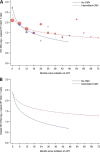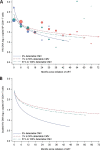Replication of Human Herpesviruses Is Associated with Higher HIV DNA Levels during Antiretroviral Therapy Started at Early Phases of HIV Infection
- PMID: 26842469
- PMCID: PMC4810527
- DOI: 10.1128/JVI.02638-15
Replication of Human Herpesviruses Is Associated with Higher HIV DNA Levels during Antiretroviral Therapy Started at Early Phases of HIV Infection
Abstract
Asymptomatic replication of human herpesviruses (HHV) is frequent in HIV-infected men and is associated with increased T-cell activation and HIV disease progression. We hypothesized that the presence of replication of cytomegalovirus (CMV) and Epstein-Barr virus (EBV) (the most frequently detected HHV) might influence HIV DNA decay during antiretroviral therapy (ART). We investigated 607 peripheral blood mononuclear cell (PBMC) samples from 107 CMV-seropositive, HIV-infected men who have sex with men, who started ART within a median of 3 months from their estimated date of infection (EDI) and were monitored for a median of 19 months thereafter. Levels of HIV, CMV, and EBV DNA and cellular HIV RNA were measured by droplet digital PCR (ddPCR) for each time point. Using a general linear mixed-effect regression model, we evaluated associations between the presence of detectable CMV DNA and EBV DNA levels and HIV DNA decay and cellular HIV RNA levels, while adjusting for peak HIV RNA, nadir CD4(+)count, CD4/CD8 ratio, CMV IgG levels, time from EDI to ART initiation, time from ART initiation to virologic suppression, detectable CMV DNA pre-ART, and age. The presence of intermittent CMV DNA in PBMC during ART was significantly associated with slower decay of HIV DNA (P= 0.011) but not with increased cellular HIV RNA transcription or more detectable 2-long terminal repeat circles. Higher levels of EBV DNA were also associated with higher levels of HIV DNA (P< 0.001) and increased unspliced cellular HIV RNA transcription (P= 0.010). These observations suggest that replication of HHV may help maintain a larger HIV DNA reservoir, but the underlying mechanisms remain unclear.
Importance: Over three-fourths of HIV-infected men have at least one actively replicating human herpesvirus (HHV) in their mucosal secretions at any one time. Cytomegalovirus (CMV) and Epstein-Barr virus (EBV) are the most common, and although it is often asymptomatic, such CMV and EBV replication is associated with higher levels of immune activation and HIV disease progression. We hypothesized that HHV-associated activation of HIV-infected CD4(+)T cells might lead to increased HIV DNA. This study found that detectable CMV in blood cells of HIV-infected men was associated with slower decay of HIV DNA even during antiretroviral therapy (ART) that was started during early HIV infection. Similarly, levels of EBV DNA were associated with higher levels of HIV DNA during ART. If this observation points to a causal pathway, interventions that control CMV and EBV replication may be able to reduce the HIV reservoir, which might be relevant to current HIV cure efforts.
Copyright © 2016, American Society for Microbiology. All Rights Reserved.
Figures


References
-
- Buzón MJ, Massanella M, Llibre JM, Esteve A, Dahl V, Puertas MC, Gatell JM, Domingo P, Paredes R, Sharkey M, Palmer S, Stevenson M, Clotet B, Blanco J, Martinez-Picado J. 2010. HIV-1 replication and immune dynamics are affected by raltegravir intensification of HAART-suppressed subjects. Nat Med 16:460–465. doi:10.1038/nm.2111. - DOI - PubMed
-
- Chun TW, Nickle DC, Justement JS, Large D, Semerjian A, Curlin ME, O'Shea MA, Hallahan CW, Daucher M, Ward DJ, Moir S, Mullins JI, Kovacs C, Fauci AS. 2005. HIV-infected individuals receiving effective antiviral therapy for extended periods of time continually replenish their viral reservoir. J Clin Invest 115:3250–3255. doi:10.1172/JCI26197. - DOI - PMC - PubMed
-
- Chomont N, El-Far M, Ancuta P, Trautmann L, Procopio FA, Yassine-Diab B, Boucher G, Boulassel MR, Ghattas G, Brenchley JM, Schacker TW, Hill BJ, Douek DC, Routy JP, Haddad EK, Sekaly RP. 2009. HIV reservoir size and persistence are driven by T cell survival and homeostatic proliferation. Nat Med 15:893–900. doi:10.1038/nm.1972. - DOI - PMC - PubMed
Publication types
MeSH terms
Substances
Grants and funding
- R01 MH101012/MH/NIMH NIH HHS/United States
- 5UM1AI068636-09/AI/NIAID NIH HHS/United States
- R25 MH081482/MH/NIMH NIH HHS/United States
- MH097520/MH/NIMH NIH HHS/United States
- U01 AI068636/AI/NIAID NIH HHS/United States
- AI007384/AI/NIAID NIH HHS/United States
- R01 MH097520/MH/NIMH NIH HHS/United States
- K24 AI100665/AI/NIAID NIH HHS/United States
- R24AI106039/AI/NIAID NIH HHS/United States
- AI036214/AI/NIAID NIH HHS/United States
- UM1 AI069432/AI/NIAID NIH HHS/United States
- T32 AI007384/AI/NIAID NIH HHS/United States
- DP1 DA034978/DA/NIDA NIH HHS/United States
- P30 AI027763/AI/NIAID NIH HHS/United States
- DA034978/DA/NIDA NIH HHS/United States
- P30 MH062512/MH/NIMH NIH HHS/United States
- P30 AI036214/AI/NIAID NIH HHS/United States
- AI100665/AI/NIAID NIH HHS/United States
- UL1 TR000100/TR/NCATS NIH HHS/United States
- U19 AI096113/AI/NIAID NIH HHS/United States
- UL1TR000100/TR/NCATS NIH HHS/United States
- R01 MH100974/MH/NIMH NIH HHS/United States
- P30-AI027763/AI/NIAID NIH HHS/United States
- UM1 AI068636/AI/NIAID NIH HHS/United States
- R24 AI106039/AI/NIAID NIH HHS/United States
LinkOut - more resources
Full Text Sources
Other Literature Sources
Medical
Research Materials

